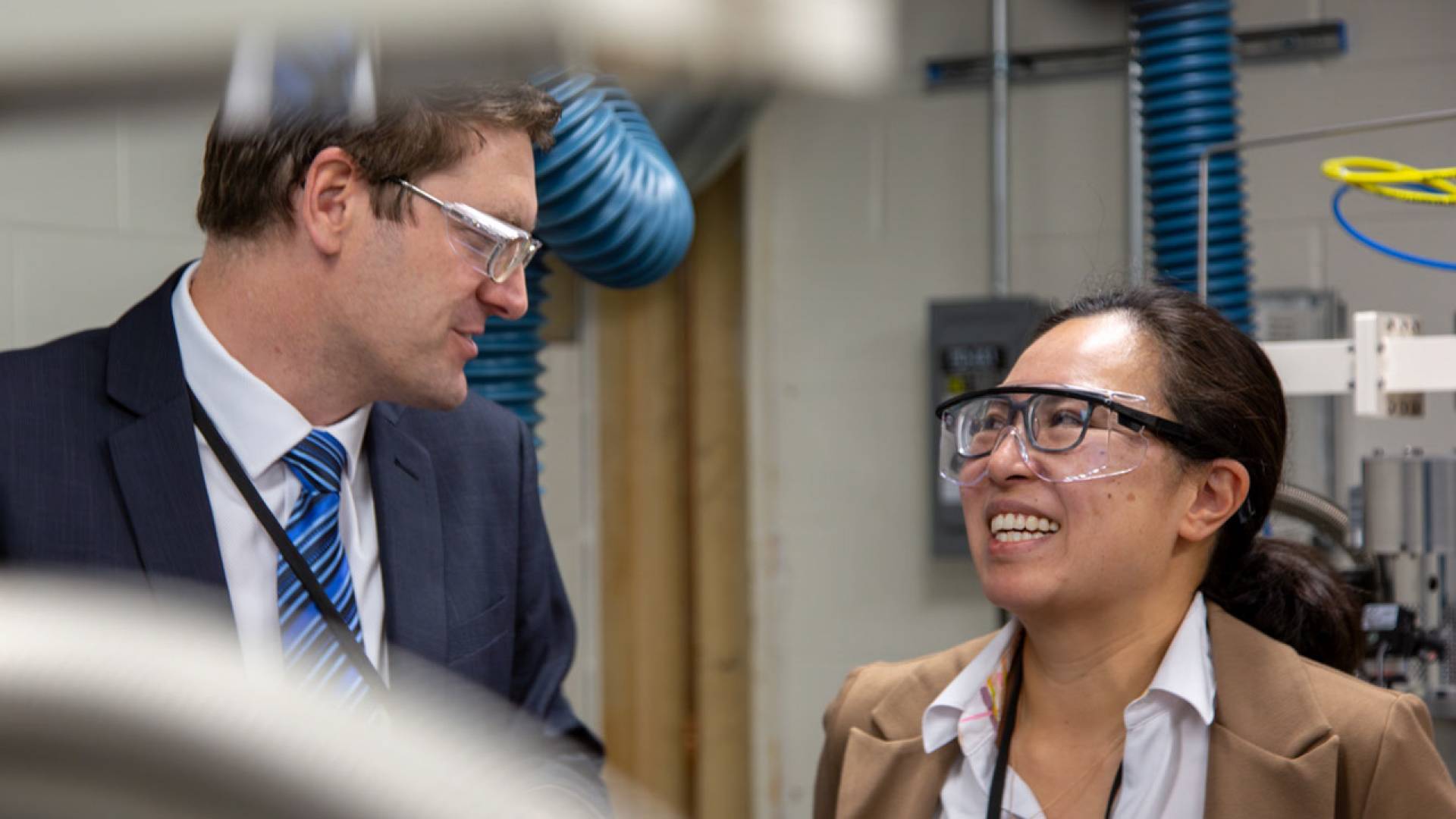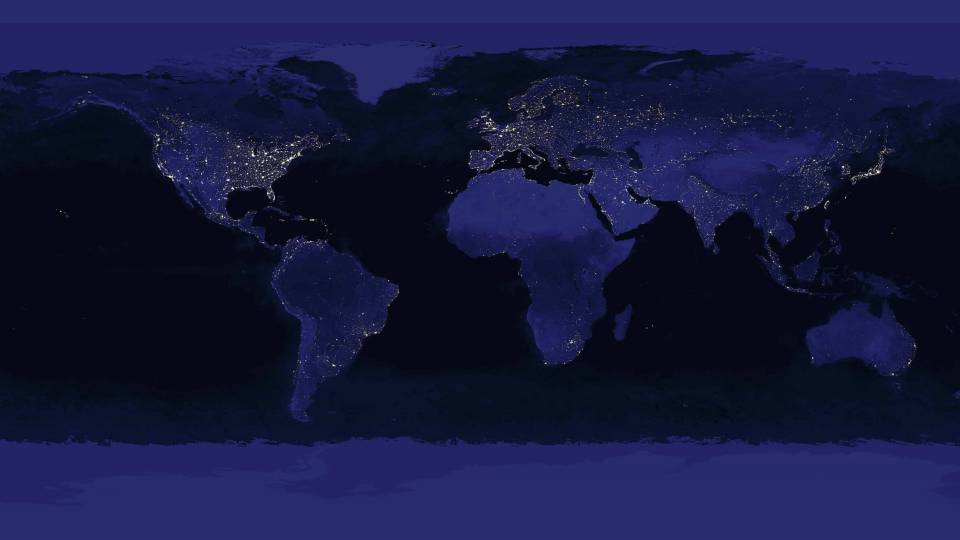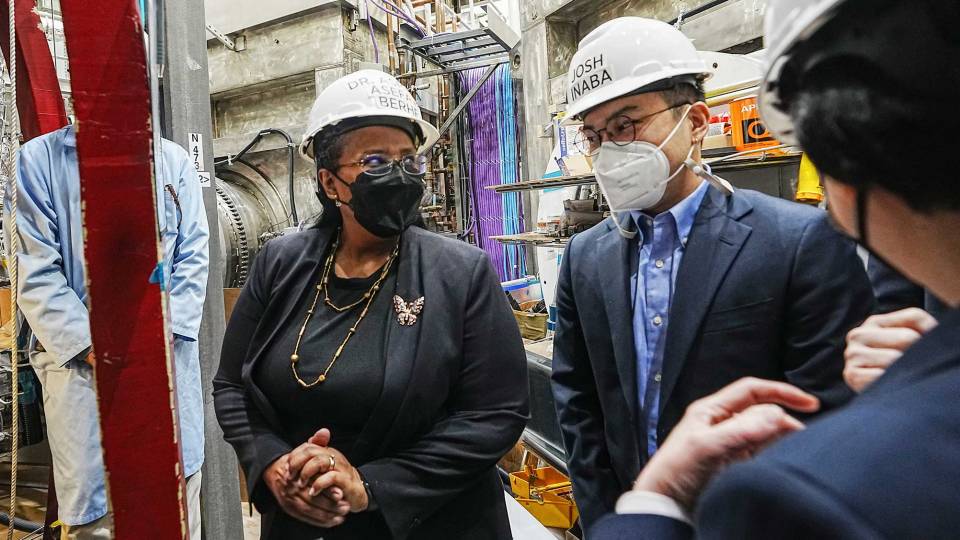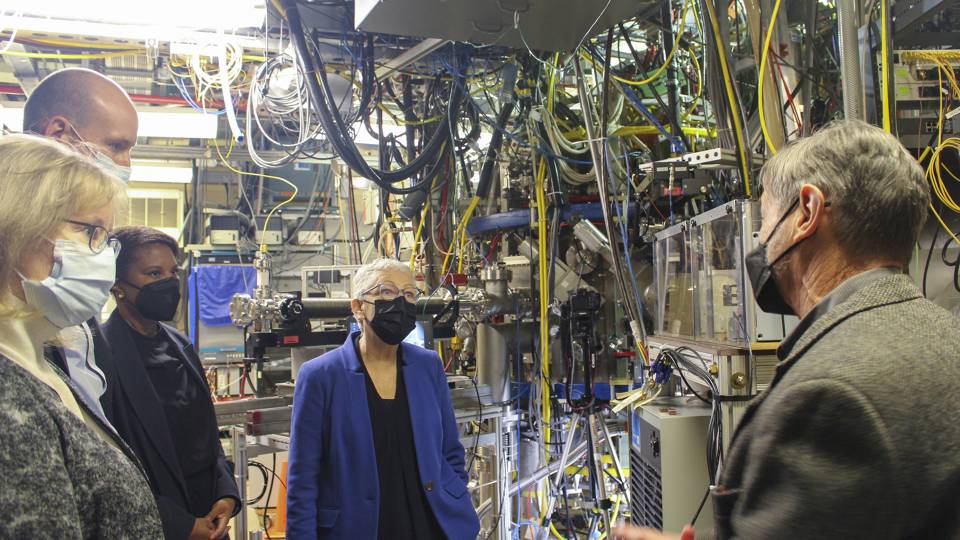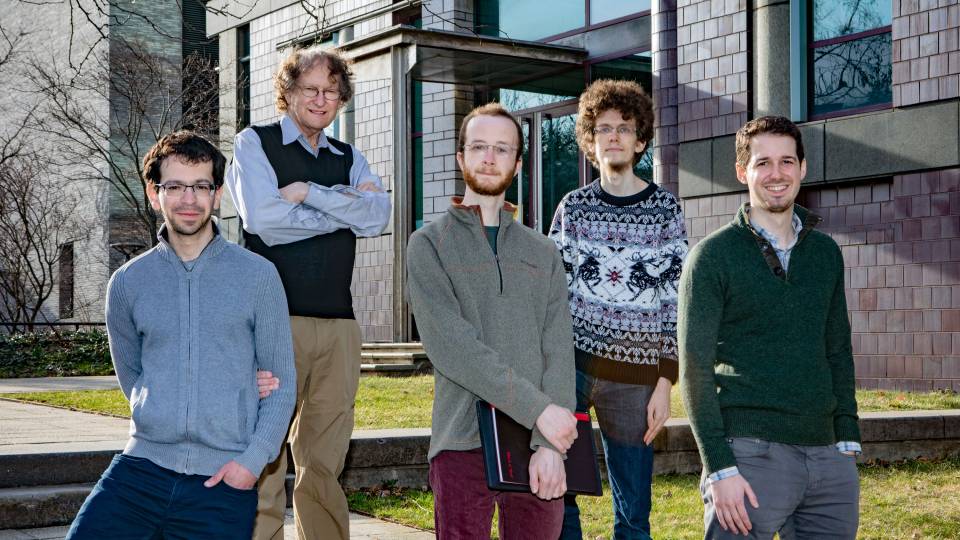Alastair Stacey, managing principal research physicist at PPPL, and Nathalie de Leon, associate professor of electrical and computer engineering at Princeton University, at PPPL's Quantum Diamond Laboratory (QDL), which De Leon helped create.
The U.S. Department of Energy’s (DOE) Princeton Plasma Physics Laboratory (PPPL) has established a new associated faculty program with Princeton University, a transformative initiative that strengthens the partnership between both institutions while forging bonds for even more powerful research collaborations.
PPPL and Princeton University have been linked for nearly 75 years since magnetic fusion research began at Princeton under the code name “Project Matterhorn.” Historically, a small number of joint faculty had appointments primarily with the Department of Astrophysical Sciences at Princeton and PPPL. Now, thanks to this new program, other Princeton University faculty who become associated faculty of PPPL will be able to apply for DOE lab-only team-based research funding, have shared lab space with the opportunity to scale up beyond the benchtop, collaborate with PPPL research staff, and lead and develop team science programs at PPPL.
These appointments are critical as PPPL expands its focus. While the Lab has long been a leader in the science and engineering behind the development of fusion energy, PPPL is now applying its expertise in plasma — the electrically charged fourth state of matter — and computational science to drive the next wave of scientific innovation to maintain U.S. leadership in critical industries
Part of this expansion involved the creation of a new directorate at the Lab: Applied Materials and Sustainability Sciences (AMSS). Led by Emily Carter and launched in 2023, this directorate focuses on the science and application of low-temperature plasmas to advance the fabrication of next-generation microelectronics and quantum information devices, as well as sustainability science, including electromanufacturing and aerosol science for the climate.
“To realize PPPL Director Steve Cowley’s vision to diversify the Laboratory’s research portfolio beyond fusion energy science, it is essential to attract scholars from other science and engineering disciplines,” said Emily Carter, PPPL’s senior strategic advisor for sustainability science and associate laboratory director for AMSS, as well as the Gerhard R. Andlinger Professor in Energy and the Environment, professor of mechanical and aerospace engineering, the Andlinger Center for Energy and the Environment, and applied and computational mathematics at Princeton University. “The associated faculty program is a win-win for PPPL and Princeton University, given the opportunities it opens up with the DOE’s Office of Science. Working with the tremendous talent at Princeton is an obvious first step in building out new research programs. Together, we will serve the nation and the world.”
“Associated faculty status enables our world-class Princeton University faculty to contribute to the research goals of PPPL and the DOE and to join a remarkable network of individuals and institutions across the world focused on advancing academic knowledge and scientific discovery,” said Gene A. Jarrett, dean of the faculty and the William S. Tod Professor of English at Princeton University. “I am looking forward to future opportunities for the University and the Laboratory to develop partnerships in the best interests of sustaining or strengthening Princeton faculty scholarship and thereby addressing the world’s greatest scientific challenges.”
Building for the future
The associated faculty program, which Carter and Kristen Fischer, chief financial officer and head of business operations at PPPL, worked for nearly a year to develop, opens new opportunities for science and engineering faculty at the University while enhancing the Laboratory’s ability to tackle the world’s toughest science and technology challenges using plasma.
“We are grateful for the leadership and support of the DOE and the University in bringing associated faculty status to fruition at PPPL,” said Fischer. “Associated faculty at PPPL will bridge our institutions in ways that set us up for success today and for decades to come.”
Carter worked with Jarrett, as well as Princeton’s Office of the Dean for Research and the Office of General Counsel to iron out details of the new program on the Princeton side, while Fischer and Carter worked with the DOE’s Princeton Site Office to set up processes that comport with DOE expectations.
Associated faculty status gives Princeton University faculty the ability to work with a department or departments outside of their primary appointment at the University. To date, four faculty at Princeton University have been named associated faculty. They are:
- Nathalie de Leon, associate professor of electrical and computer engineering at Princeton.
- Luc Dieke, associate professor in the Department of Mechanical and Aerospace Engineering and the High Meadows Environmental Institute and head of aerosol science for the climate at PPPL.
- Yiguang Ju, the Robert Porter Patterson Professor in the Department of Mechanical and Aerospace Engineering, head of electromanufacturing science at PPPL and director of the DOE Energy Earthshot Research Center at PPPL as part of the Hydrogen Shot™.
- Marissa Weichman, assistant professor of chemistry.
PPPL will continue to grow the number of associated faculty at the Laboratory across all areas of scientific research aligned with its research diversification efforts.
Enhancing collaboration
For associated faculty at PPPL, the new role enhances the ability to collaborate and build upon existing relationships.
“Climate change and energy sustainability are two of the most important issues facing humankind,” said Ju, whose research at Princeton has focused on the combustion of renewable and fossil fuels, using biofuels for transportation and flight, and electrified manufacturing. At PPPL, Ju is leading the AMSS electromanufacturing division. Electromanufacturing investigates ways to replace the energy provided by fossil fuels with clean electricity, including using plasmas in several industrial processes.
“The new associated faculty position significantly simplifies and smooths collaboration,” Ju said. “If you are looking at decarbonization, it’s not something a single principal investigator can do and have a huge impact. The fundamental expertise that PPPL has and the student resources at the University position us well to attract and win national research centers and investment from leading companies to create new technologies and startup companies.”
“This is a natural next step given my current projects and collaborations with the Lab,” added de Leon, who for the past two years has been part of the team working to establish PPPL’s Quantum Diamond Laboratory, a space devoted to studying and refining the processes involved in using plasma to create high-quality diamond material for quantum information science applications.
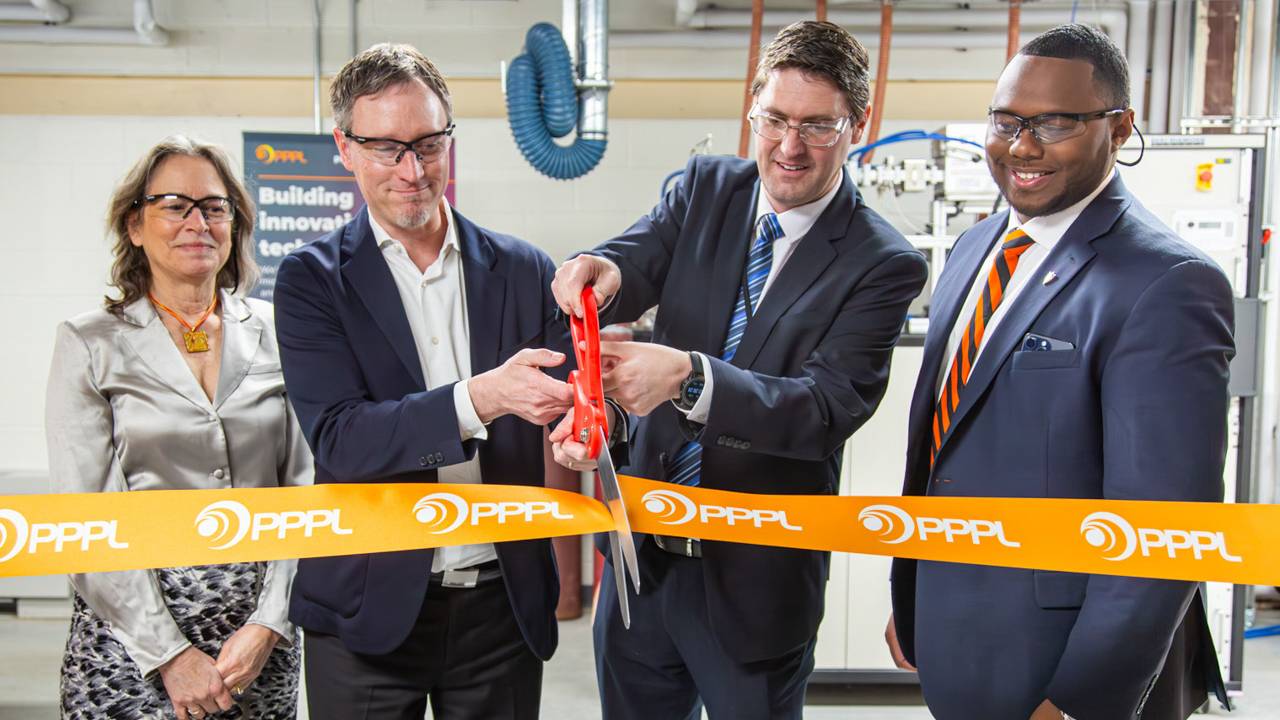
PPPL’s Quantum Diamond Laboratory was officially opened by (from left): Emily Carter, PPPL’s senior strategic advisor and associate laboratory director for applied materials and sustainability sciences, as well as the Gerhard R. Andlinger Professor in Energy and the Environment, professor of mechanical and aerospace engineering, the Andlinger Center for Energy and the Environment, and applied and computational mathematics at Princeton University; Tim Meyer, PPPL’s chief operating officer; Alastair Stacey, managing principal research physicist at PPPL; and Brandon Thorne, director of the Office of the Vice President for PPPL at Princeton University.
“What we’re really trying to do is organically build up a research program piece by piece,” she continued. “[Previously,] people hadn’t taken a close look at whether we could learn how to grow diamond better by actually understanding plasma science and plasma chemistry. It’s really exciting to do something at this scale, and I see it as a potential way to really push the frontier in a way that people have not been able to do before.”
Forging new pathways
In addition to leading the science and engineering behind the development of fusion — a clean, safe and virtually limitless energy source — PPPL uses its experimental and computational strengths in plasma, engineering, and electrochemical and materials science to help sustainably decarbonize multiple industries. The Laboratory is working with the semiconductor industry to develop new ways to fabricate microchips, create the next generation of quantum diamond sensors and investigate ways to replace fossil fuels with electricity, including plasmas, in industrial processes. PPPL is also embarking on a new focus on aerosol science for the climate.
Even as industries and economies transition away from fossil fuels and work to remove greenhouse gases from the atmosphere, it may be that these transitions cannot happen fast enough, necessitating the exploration of other temporary measures to help ensure the planet avoids reaching a tipping point. One solution could be to explore how part of the sun’s energy might be intentionally reflected back to space to help cool the planet temporarily.
At PPPL, Deike, Weichman, and Yevgeny Raitses, managing principal research physicist at PPPL, are developing experiments and measurement tools to study how clouds, light and aerosols — small particles in the air — interact in controlled laboratory conditions to safely determine the science underpinning such cooling strategies.
“My research is in fluid mechanics,” said Deike. “My work involves waves, droplets and bubbles and how they feed into large-scale questions and problems. I study small-scale processes and how they link to large-scale environmental changes.”
“I’m really excited because I’ve already been collaborating with folks at PPPL and in the Geosciences and Engineering departments on campus in a new thrust of sustainability research with a particular focus on atmospheric aerosols and how we might use them rationally to mitigate climate change,” said Weichman. “This is the cherry on the top to get this more formal appointment at PPPL to make those connections deeper and more meaningful and create this longer, ongoing research thrust where we might be able to create a real team and make some progress.”
